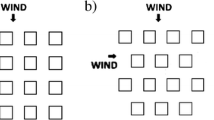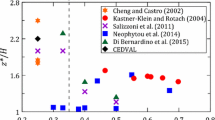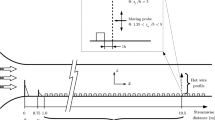Abstract
We present an objective optimization procedure to determine the roughness parameters for very rough boundary-layer flow over model urban canopies. For neutral stratification the mean velocity profile above a model urban canopy is described by the logarithmic law together with the set of roughness parameters of displacement height d, roughness length \(z_0\), and friction velocity \(u_*\). Traditionally, values of these roughness parameters are obtained by fitting the logarithmic law through (all) the data points comprising the velocity profile. The new procedure generates unique velocity profiles from subsets or combinations of the data points of the original velocity profile, after which all possible profiles are examined. Each of the generated profiles is fitted to the logarithmic law for a sequence of values of d, with the representative value of d obtained from the minima of the summed least-squares errors for all the generated profiles. The representative values of \(z_0\) and \(u_*\) are identified by the peak in the bivariate histogram of \(z_0\) and \(u_*\). The methodology has been verified against laboratory datasets of flow above model urban canopies.









Similar content being viewed by others
References
Amir M, Castro IP (2011) Turbulence in rough-wall boundary layers: universality issues. Exp Fluids 51(2):313–326
Andreas EL, Claffey KJ, Jordan RE, Fairall CW, Guest PS (2006) Evaluations of the von Kármán constant in the atmospheric surface layer. J Fluid Mech 559:117–149
Barlow JF (2014) Progress in observing and modelling the urban boundary layer. Urban Clim 10:216–240
Britter R, Hanna S (2003) Flow and dispersion in urban areas. Annu Rev Fluid Mech 35(1):469–496
Castro IP, Cheng H, Reynolds R (2006) Turbulence over urban-type roughness: deductions from wind-tunnel measurements. Boundary-Layer Meteorol 118(1):109–131
Cheng H, Castro IP (2002) Near wall flow over urban-like roughness. Boundary-Layer Meteorol 104(2):229–259
Cheng H, Hayden P, Robins AG, Castro IP (2007) Flow over cube arrays of different packing densities. J Wind Eng Ind Aerodyn 95(8):715–740
Cionco RM (1965) A mathematical model for air flow in a vegetative canopy. J Appl Meteorol 4(4):517–522
Collier CG (2006) The impact of urban areas on weather. Q J R Meteorol Soc 132(614):1–25
Counihan J (1969) An improved method of simulating an atmospheric boundary layer in a wind tunnel. Atmos Environ 3(2):197–200
Fernando H (2010) Fluid dynamics of urban atmospheres in complex terrain. Annu Rev Fluid Mech 42:365–389
Flack K, Schultz M (2010) Review of hydraulic roughness scales in the fully rough regime. J Fluids Eng 132(4):041203
Flack KA, Schultz MP, Shapiro TA (2005) Experimental support for Townsend’s Reynolds number similarity hypothesis on rough walls. Phys Fluids 17(3):035102
Foken T (2008) Micrometeorology. Springer, Berlin
Garratt JR (1994) The atmospheric boundary layer. Cambridge University Press, Cambridge, UK
Graf A, Boer A, Moene A, Vereecken H (2014) Intercomparison of methods for the simultaneous estimation of zero-plane displacement and aerodynamic roughness length from single-level eddy-covariance data. Boundary-Layer Meteorol 151(2):373–387
Grimmond CSB, Oke TR (1999) Aerodynamic properties of urban areas derived from analysis of surface form. J Appl Meteorol 38(9):1262–1292
Grimmond CSB, Oke TR (2002) Turbulent heat fluxes in urban areas: observations and a local-scale urban meteorological parameterization scheme (LUMPS). J Appl Meteorol 41(7):792–810
Hagishima A, Tanimoto J, Nagayama K, Meno S (2009) Aerodynamic parameters of regular arrays of rectangular blocks with various geometries. Boundary-Layer Meteorol 132(2):315–337
Hanna SR, Tehranian S, Carissimo B, Macdonald RW, Lohner R (2002) Comparisons of model simulations with observations of mean flow and turbulence within simple obstacle arrays. Atmos Environ 36:5067–5079
Huq P, Franzese P (2013) Measurements of turbulence and dispersion in three idealized urban canopies with different aspect ratios and comparisons with a Gaussian plume model. Boundary-Layer Meteorol 147:103–121
Huq P, Carrillo A, White LA, Redondo J, Dharmavaram S, Hanna SR (2007) The shear layer above and in urban canopies. J Appl Meteorol Clim 46:368–376
Inoue E (1963) On the turbulent structure of airflow within crop canopies. J Meteorol Soc Jpn Ser II 41(6):317–326
Jimenez J (2004) Turbulent flow over rough walls. Annu Rev Fluid Mech 36:173–196
Kaimal JC, Finnigan JJ (1994) Atmospheric boundary layer flows: their structure and measurement. Oxford University Press, New York, p 289
Kanda M, Inagaki A, Miyamoto T, Gryschka M, Raasch S (2013) A new aerodynamic parametrization for real urban surfaces. Boundary-Layer Meteorol 148(2):357–377
Kastner-Klein P, Rotach MW (2004) Mean flow and turbulence characteristics in an urban roughness sublayer. Boundary-Layer Meteorol 111(1):55–84
Kawaguchi Y, Senda T, Ando H, Kawashima H, Iwamoto K, Motozawa M, Ito T, Matsumoto A, Ito T (2011) Experimental investigation on effects of surface roughness geometry affecting to flow resistance. In: ASME-JSME-KSME 2011 joint fluids engineering conference. ASME, New York, pp 3945–3954
Kent CW, Grimmond S, Barlow J, Gatey D, Kotthaus S, Lindberg F, Halios CH (2017) Evaluation of urban local-scale aerodynamic parameters: implications for the vertical profile of wind speed and for source areas. Boundary-Layer Meteorol 164(2):183–213
Leonardi S, Castro IP (2010) Channel flow over large cube roughness: a direct numerical study. J Fluid Mech 651:519–539
Lettau H (1969) Note on aerodynamic roughness-parameter estimation on the basis of roughness-element description. J Appl Meteorol 8(5):828–832
Macdonald RW (2000) Modelling the mean velocity profile in the urban canopy layer. Boundary-Layer Meteorol 97(1):25–45
Macdonald RW, Griffiths RF, Hall DJ (1998) An improved method for the estimation of surface roughness of obstacle arrays. Atmos Environ 32(11):1857–1864
Macdonald RW, Carter S, Slawson PR (2000) Measurements of mean velocity and turbulence statistics in simple obstacle arrays at 1:200 scale. Thermal Fluids Report 2000-1, Department of Mechanical Engineering, University of Waterloo
McKeon BJ, Li J, Jiang W, Morrison JF, Smits AJ (2004) Further observations on the mean velocity distribution in fully developed pipe flow. J Fluid Mech 501:135–147
Milliez M, Carissimo B (2007) Numerical simulations of pollutant dispersion in an idealized urban area, for different meteorological conditions. Boundary-Layer Meteorol 122(2):321–342
Mohammad A, Zaki S, Hagishima A, Ali M (2014) Determination of aerodynamic parameters of urban surfaces: methods and results revisited. Theor Appl Climatol 122(3–4):635–649
Oke TR (1987) Boundary layer climates, 2nd edn. Routledge, London
Paeschke W (1937) Experimentelle untersuchungen zum rauhigkeits und stabilitaets-problem in der freien atmosphere. Beitr Phys Atmos 24:163–189
Raupach M, Thom AS (1981) Turbulence in and above plant canopies. Annu Rev Fluid Mech 13(1):97–129
Reynolds RT, Castro IP (2008) Measurements in an urban-type boundary layer. Exp Fluids 45(1):141–156
Rossby CG, Montgomery RB (1935) The layer of frictional influence in wind and ocean currents. Pap Phys Oceanogr Meteorol 3(3):1–101
Roth M (2000) Review of atmospheric turbulence over cities. Q J R Meteorol Soc 126(564):941–990
Shinn JH (1971) Steady-state two-dimensional air flow in forests and the disturbance of surface layer flow by a forest wall. Atmospheric Sciences Lab, White Sands Missile Range, New Mexico
Shockling M, Allen J, Smits AJ (2006) Roughness effects in turbulent pipe flow. J Fluid Mech 564:267–285
Smits AJ, McKeon BJ, Marusic I (2011) High Reynolds number wall turbulence. Annu Rev Fluid Mech 43:353–375
Sogachev A, Kelly M (2016) On displacement height, from classical to practical formulation: stress, turbulent transport and vorticity considerations. Boundary-Layer Meteorol 158(3):361–381
Stull RB (1988) An introduction to boundary-layer meteorology. Kluwer, Dordrecht
Thom A (1971) Momentum absorption by vegetation. Q J R Meteorol Soc 97:414–428
Townsend AA (1980) The structure of turbulent shear flow, 2nd edn. Cambridge University Press, Cambridge, UK
Wieringa J (1993) Representative roughness parameters for homogeneous terrain. Boundary-Layer Meteorol 63(4):323–363
Yee E, Gailis RM, Hill A, Hilderman T, Kiel D (2006) Comparison of wind-tunnel and water-channel simulations of plume dispersion through a large array of obstacles with a scaled field experiment. Boundary-Layer Meteorol 121(3):389–432
Zaki SA, Hagishima A, Tanimoto J, Ikegaya N (2011) Aerodynamic parameters of urban building arrays with random geometries. Boundary-Layer Meteorol 138(1):99–120
Zhu X, Iungo GV, Leonardi S, Anderson W (2017) Parametric study of urban-like topographic statistical moments relevant to a priori modelling of bulk aerodynamic parameters. Boundary-Layer Meteorol 162(2):231–253
Author information
Authors and Affiliations
Corresponding author
Appendix
Appendix
The equations involved in the least-squares procedure for determining the friction velocity and roughness length are presented here. The friction velocity \(u_*/U_H\) is obtained from the slope
and the non-dimensional friction velocity \(u_*/U_H = \kappa /m\), thus
and the roughness length \(z_0/H\) is obtained from the intercept
and the non-dimensional roughness length \(z_0/H=\exp (C)\), thus
where \(\Sigma \) represents a summation, and k is the number of data points for a profile.
Rights and permissions
About this article
Cite this article
Huq, P., Rahman, A. Optimizing the Determination of Roughness Parameters for Model Urban Canopies. Boundary-Layer Meteorol 168, 497–515 (2018). https://doi.org/10.1007/s10546-018-0352-8
Received:
Accepted:
Published:
Issue Date:
DOI: https://doi.org/10.1007/s10546-018-0352-8




